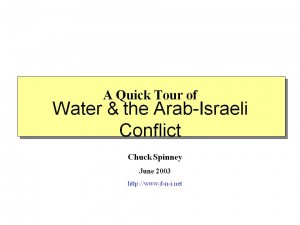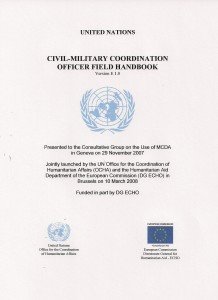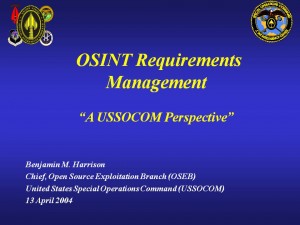Del Spurlock Jr.: Our Obligations to Wounded Warriors
07 Health, Ethics, Military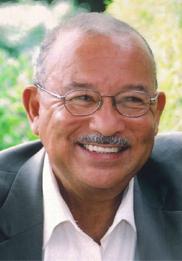
Our failure to plan for the return of our soldiers wounded in our Global War on Terrorism has made it necessary to examine our unprepared and overwhelmed military/veterans health care system. Much is at stake. We are engaged in de facto perpetual war that depends on volunteers for victory. On July 31, after five months of analysis and deliberation, the President's Commission on Care for America's Returning Wounded Warriors will present its recommendations. Co-Chairs Senator Bob Dole and former Secretary of Health Donna Shalala, both experienced and deeply committed to the task, will propose changes. The most significant effects of their recommendations upon the Nation and our maimed, cognitively impaired and traumatized service members and their families will accrue over a generation or more.
On that not yet foreseeable day when oil flows out of Iraq and international oil interests trumpet the event, wounded veterans will be reminded anew of their enduring courage and self-sacrifice, a gift to the Nation that made it possible for the rest of us to avoid conscription. Fraught with combat memories, flashbacks, and disabilities, that reminder could never be sweet, but it will not be bitter if they find themselves as welcome in rehabilitation as they were in recruitment.
When the Commission presents its recommendations, some 3,200 of our volunteer soldiers will have been killed in Iraq and Afghanistan, and about 900 will have died of “non-hostile” accidents, heat exhaustion and illness. Officially, about 28,075 have already been wounded: unofficial but authoritative analysis nearly doubles that number. But the signature wound of this war is a type of traumatic brain injury (TBI) resulting from the blast forces of improvised explosive devices (IEDs). Blast-TBI (bTBI) is invisible to the naked eye as is post-traumatic stress disorder (PTSD). Military doctors tell us that the official count underestimates the number of our soldiers who will return to their families, communities and employers with TBI’s slowed thinking, deficits in attention and concentration, headaches, memory loss, sleep disturbance, and irritability and with PTSD’s flashbacks and crippling emotional conditions. The number of invisibly wounded soldiers now exceeds the number of visibly wounded. We must not feign blindness to the epidemic we have brought home from this war.
Continue reading “Del Spurlock Jr.: Our Obligations to Wounded Warriors”
Military Archives on Public Intelligence (1992-2006)
Military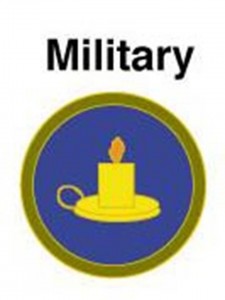
2005 Steele to Hayden Asking for Naquin Cease & Desist
History of Opposition, Legislation, Military, PolicyDoug Naquin, the senior Central Intelligence (CIA) officer responsible for Open Source Intelligence (OSINT) and for the Open Source Center (OSC), the half-baked replacement for the Foreign Broadcast Information Service (FBIS), is a good person trapped in a bad system. He not only does not know what he does not know, but is held in multiple strait-jackets by CIA security, CIA legal, and CIA culture.
In November 2005 we recognized the severe damage that Doug Naquin–with the best of intentions–was doing to the US military, and we tried to stop him. Below is the letter that was sent to the Deputy Director of National Intelligence, General Michael Hayden, USAF. He ignored the letter.
Naquin is still doing damage. Apart from misrepresentations to the Combatant Commanders (COCOMs), the personnel exchange is sending unqualified FBIS/OSC people out to the military where they not only have no clue, but they also try to spin everything to CIA's advantage. The Department of Defense (DoD) needs to realize that the OSC is not a “full-spectrum” OSINT shop; that it can barely handle CIA's own internal requirements (and by some accounts, is considered argely worthless among the CIA analysts as well)
This letter was on target. It is still on target. It is time for Doug Naquin to do what he does best: stay on campus at CIA and stop messing up the US military with misprepresentations, failures to perform, and exported personnel that are not worth the C Rations it takes to feed them.
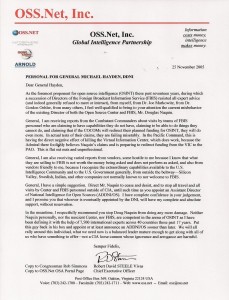
2004 Harrison (US) Open Source Intelligence (OSINT) Requirements Management: A U.S. Special Operations Command (USSOCOM) Perspective
Historic Contributions, Methods & Process, Military

PLATINUM LIFETIME AWARD, Mr. Ben Harrison, OSINT Pioneer
Mr. Ben Harrison is a master of both the military bureaucracy, and the global open source intelligence (OSINT) world. He has been a pioneer in all respects–helping the larger Department of Defense Community understand OSINT; creating innovative solutions for his own Command, the U.S. Special Operations Command; and helping teach otherss about the basics of OSINT. Within the U.S. Department of Defense, he is the tip of the spear for DoD OSINT.
USSOCOM is still the only “full spectrum” Open Source Intelligence (OSINT) shop in the US Government–others do foreign media (in a handful of languages), document exploitation, legal traveler exploitation, but only USSOCOM does full-spectrum Black, Gray, and White OSINT that connects one bullet to one target. Below is his presentation to OSS '04.
2004 Marlatt (US) Military Librarianship in an Academic Environment
Academia, Historic Contributions, Methods & Process, Military
Greta Marlatt is one of the librarian “top guns” at the Naval Postgraduate School (NPS) in Monteray, California. The photo leads to her official page at NPS.
She is known for many fine accomplishments but among them is her continuously updated bibliography on intelligence and public policy.
The HTML version online does not appear to be available at this time (Aug 09).
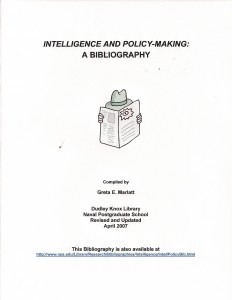
Below is her presentation to OSS '04,
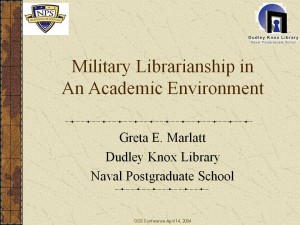
2004 (US) Spinney Water and the Arab-Israeli Conflict
06 Genocide, 12 Water, Civil Society, Earth Intelligence, Government, Historic Contributions, Military, Peace Intelligence
Chuck Spinney, who contributes highlighted items to the Journal of Public Intelligence, wrote the original modern book on defense waste and the plans/reality mismatch, shown below with a link to its Amazon Page.
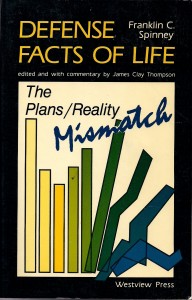
Although not a professional intelligence analyst, Spinney is a deeply-experienced real-world analyst and understands the lunacy of building a strategy, a force structure, a foreign policy, or a campaign plan on ideological fantasies and misrepresentations. Israel and Palestine is a WATER issue, nothing more, nothing less. Below is his briefing to OSS '04 to that effect–prepare to be shocked at how Israel is stealing water from the Arab aquifers, and how Israeli agruculture is using 50% of the regions water to produce less than 5% of the Israeli GDP, all the while denying Palestinians their own water. The Arab govenrments, and the US Government, “go along” because they do not yet place proper emphasis on human rights and especially on the rights of indigenous peoples.
